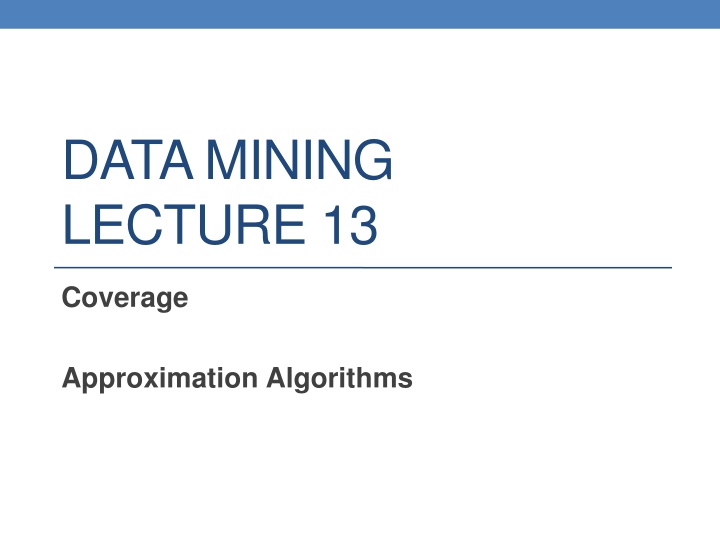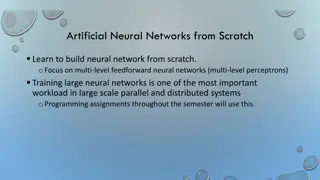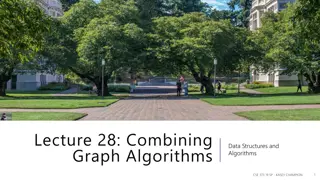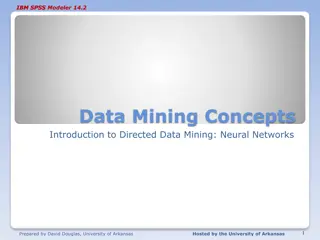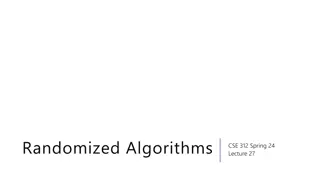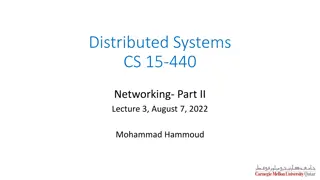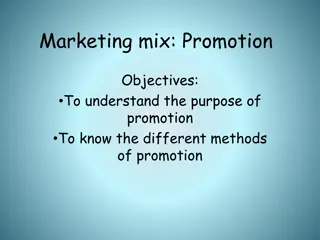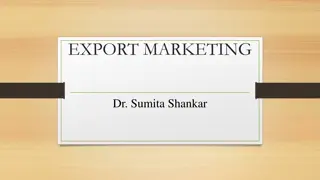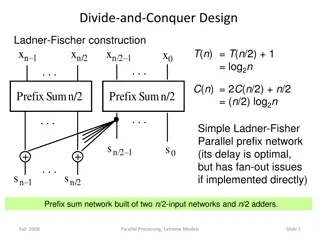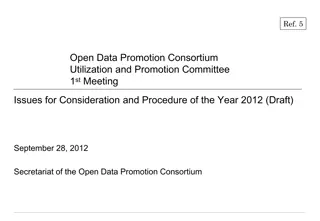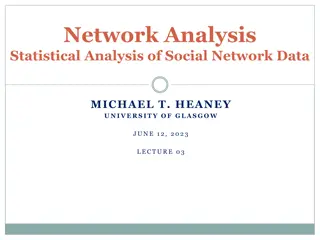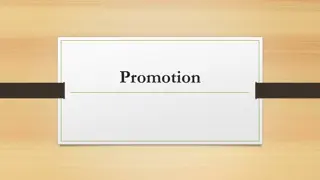Efficient Covering Algorithms for Promotion Campaigns in Social Networks
This lecture explores the use of approximation algorithms to minimize the number of free products offered in a promotion campaign on a social network. It discusses the Dominating Set Problem and its relation to the Set Cover Problem, providing examples and applications in creating catalogs for store customers.
Download Presentation

Please find below an Image/Link to download the presentation.
The content on the website is provided AS IS for your information and personal use only. It may not be sold, licensed, or shared on other websites without obtaining consent from the author.If you encounter any issues during the download, it is possible that the publisher has removed the file from their server.
You are allowed to download the files provided on this website for personal or commercial use, subject to the condition that they are used lawfully. All files are the property of their respective owners.
The content on the website is provided AS IS for your information and personal use only. It may not be sold, licensed, or shared on other websites without obtaining consent from the author.
E N D
Presentation Transcript
DATA MINING LECTURE 13 Coverage Approximation Algorithms
Example Promotion campaign on a social network We have a social network as a graph. People are more likely to buy a product if they have a friend who has the product. We want to offer the product for free to some people such that every person in the graph is covered: they have a friend who has the product. We want the number of free products to be as small as possible
Example Promotion campaign on a social network We have a social network as a graph. People are more likely to buy a product if they have a friend who has the product. We want to offer the product for free to some people such that every person in the graph is covered: they have a friend who has the product. We want the number of free products to be as small as possible One possible selection
Example Promotion campaign on a social network We have a social network as a graph. People are more likely to buy a product if they have a friend who has the product. We want to offer the product for free to some people such that every person in the graph is covered: they have a friend who has the product. We want the number of free products to be as small as possible A better selection
Dominating set Our problem is an instance of the dominating set problem Dominating Set: Given a graph ? = (?,?), a set of vertices ? ? is a dominating set if for each node u in V, either u is in D, or u has a neighbor in D. The Dominating Set Problem: Given a graph ? = (?,?) find a dominating set of minimum size.
Set Cover The dominating set problem is a special case of the Set Cover problem The Set Cover problem: We have a universe of elements ? = ?1, ,?? We have a collection of subsets of U, ? = {?1, ,??}, such that ???= ? We want to find the smallest sub-collection ? ? of ?, such that ?? ???= ? The sets in ? cover the elements of U
An application of Set Cover Suppose that we want to create a catalog (with coupons) to give to customers of a store: We want for every customer, the catalog to contain a product bought by the customer (this is a small store) How can we model this as a set cover problem?
Applications 1 milk The universe U of elements is the set of customers of a store. Each set corresponds to a product p sold in the store: ??= {????????? ? ?? ???? ? ?} Set cover: Find the minimum number of products (sets) that cover all the customers (elements of the universe) 2 coffee 3 coke 4 5 beer 6 tea 7
Applications 1 milk The universe U of elements is the set of customers of a store. Each set corresponds to a product p sold in the store: ??= {????????? ? ?? ???? ? ?} Set cover: Find the minimum number of products (sets) that cover all the customers (elements of the universe) 2 coffee 3 coke 4 5 beer 6 tea 7
Applications 1 milk The universe U of elements is the set of customers of a store. Each set corresponds to a product p sold in the store: ??= {????????? ? ?? ???? ? ?} Set cover: Find the minimum number of products (sets) that cover all the customers (elements of the universe) 2 coffee 3 coke 4 5 beer 6 tea 7
Applications Dominating Set (or Promotion Campaign) as Set Cover: The universe U is the set of nodes V Each node ? defines a set ?? consisting of the node ? and all of its neighbors We want the minimum number of sets ?? (nodes) that cover all the nodes in the graph. Many more
Best selection variant Suppose that we have a budget K of how big our set cover can be We only have K products to give out for free. We want to cover as many customers as possible. Maximum-Coverage Problem: Given a universe of elements ?, a collection ? of subsets of ?, and a budget K, find a sub-collection ? ? of size at most K, such that the number of covered elements ?? ??? is maximized.
Complexity Both the Set Cover and the Maximum Coverage problems are NP-complete What does this mean? Why do we care? There is no algorithm that can guarantee finding the best solution in polynomial time Can we find an algorithm that can guarantee to find a solution that is close to the optimal? Approximation Algorithms.
Approximation Algorithms For an (combinatorial) optimization problem, where: X is an instance of the problem, OPT(X) is the value of the optimal solution for X, ALG(X) is the value of the solution of an algorithm ALG for X ALG is a good approximation algorithm if the ratio of OPT(X) and ALG(X) is bounded for all input instances X Minimum set cover: input X = (U,S) is the universe of elements and the set collection, OPT(X) is the size of minimum set cover, ALG(X) is the size of the set cover found by an algorithm ALG. Maximum coverage: input X = (U,S,K) is the input instance, OPT(X) is the coverage of the optimal algorithm, ALG(X) is the coverage of the set found by an algorithm ALG.
Approximation Algorithms For a minimization problem, the algorithm ALG is an ?- approximation algorithm, for ? > 1, if for all input instances X, ??? ? ???? ? In simple words: the algorithm ALG is at most ? times worse than the optimal. ? is the approximation ratio of the algorithm we want ? to be as close to 1 as possible Best case: ? = 1 + ? and ? 0, as ? (e.g., ? = Good case: ? = ?(1) is a constant (e.g., ? = 2) OK case: ? = O(log?) Bad case ? = O(??) 1 ?)
Approximation Algorithms For a maximization problem, the algorithm ALG is an ?- approximation algorithm, for ? < 1, if for all input instances X, ??? ? ???? ? In simple words: the algorithm ALG achieves at least ? percent of what the optimal achieves. ? is the approximation ratio of the algorithm we want ? to be as close to 1 as possible Best case: ? = 1 ? and ? 0, as ? (e.g., ? = Good case: ? = ?(1) is a constant (e.g., ? = 0.5) OK case: ? = ?( log ?) Bad case ? = O(? ?) 1 ?) 1
A simple approximation ratio for set cover Lemma: Any algorithm for set cover has approximation ratio ? = |????|, where ???? is the set in ? with the largest cardinality Proof: ???(?) ?/|????| ? |????|???(?) ???(?) ? |????|???(?) This is true for any algorithm. Not a good bound since it may be that ????= ? ?
An algorithm for Set Cover What is a natural algorithm for Set Cover? Greedy: each time add to the collection ? the set ?? from ? that covers the most of the remaining uncovered elements.
The GREEDY algorithm GREEDY(U,S) X= U C = {} while X is not empty do For all ?? ? let gain(??) = |?? ?| Let ? be such that ????(? ) is maximum C = C U {S*} X = X\ S* S = S\ S* The number of elements covered by ?? not already covered by ?.
Greedy is not always optimal Optimal Greedy 1 1 milk milk 2 2 coffee coffee 3 3 coke coke 4 4 5 5 beer beer 6 6 tea tea 7 7
Greedy is not always optimal Optimal Greedy 1 1 milk milk 2 2 coffee coffee 3 3 coke coke 4 4 5 5 beer beer 6 6 tea tea 7 7
Greedy is not always optimal Optimal Greedy 1 1 milk milk 2 2 coffee coffee 3 3 coke coke 4 4 5 5 beer beer 6 6 tea tea 7 7
Greedy is not always optimal Optimal Greedy 1 1 milk milk 2 2 coffee coffee 3 3 coke coke 4 4 5 5 beer beer 6 6 tea tea 7 7
Greedy is not always optimal Optimal Greedy 1 1 milk milk 2 2 coffee coffee 3 3 coke coke 4 4 5 5 beer beer 6 6 tea tea 7 7
Greedy is not always optimal Adding Coke to the set is useless. 1 1 milk milk 2 2 coffee coffee 3 3 coke coke We need Milk (or Coffee) and Beer to cover all customers 4 4 5 5 beer beer 6 6 tea tea 7 7
Approximation ratio of GREEDY Good news: GREEDY has approximation ratio: ? 1 ? ? = ? ?max = 1 + ln ?max, ? ? = ?=1 ?????? ? 1 + ln ?max ??? ? , for all X
Maximum Coverage Greedy is also applicable here GREEDY(U,S,K) X = U C = {} while |C| < K For all ?? ? let gain(??) = |?? ?| Let ? be such that ????(? ) is maximum C = C U {S*} X = X\ S* S= S\ S* The number of elements covered by ?? not already covered by ?.
Approximation Ratio for Max-K Coverage Better news! The GREEDY algorithm has approximation ratio ? = 1 1 ? ?????? ? 1 1 ???? ? , for all X (e is the basis of the natural logarithm) The coverage of the Greedy solution is at least 63% that of the optimal
Proof of approximation ratios We will now give a proof of the approximation ratios for the SET-COVER and the MAX-COVERAGE We start with MAX-COVERAGE Definitions: ???: size of the optimal solution ??: number of covered elements at iteration ? of Greedy ??: number of newly covered elements at iteration ? ??= ??? ??: difference between solution size of Optimal and Greedy solutions at iteration ?.
Lemma: ??+1?? Proof: For ? = 0, it is simple to see since one of the K sets in the optimal solution has size at least ??? ? ?. For larger ? Universe Optimal solution for K = 5 Greedy solution at iteration ? ??: intersection of optimal and Greedy solutions ?? ?? ??: number of optimal subsets fully included in the Greedy solution: ?? 0 There must be a set with ??+1 ??? ?? ? ?? OPT ?? ? ??= 3 ??? ?? =?? ? ?
?+1 Lemma: ??+1 1 1 ??? ? Proof: By induction on ?. Basis of induction: ?0 1 1 ???? Use the fact that ?0= ???, and ?1= ?1 ? Inductive Hypothesis: ?? 1 1 ??? ? ?+1 Inductive step: ??+1 1 1 ??? ? ?+1?? and Use the inductive hypothesis and that ??+1= ?=1 ??+1= ?? ??
Theorem: The Greedy algorithm has approximation ratio 1 1 ? Proof: ? ?? 1 1 ??? 1 ???? ? The size of the Greedy solution is ?? ??= ??? ?? 1 1 ??? ?
Proof for SET COVER In the case of SET COVER, we have that ??? = ? Let ? be the size of the optimal solution. ? 1 ? We know that after ? iterations: ?? 1 ? ? iterations ?? ? elements remain to be covered We can cover those in at most ? iterations Total iterations are at most ? (ln ?. After ? = ? ln ? ? + 1) ? (ln? + 1)
Lower bound The approximation ratio is tight up to a constant Tight means that we can find a counter example with this ratio ???(?) = 2 ??????(?) = log? ? =1 2log?
Another proof of the approximation ratio for MAX-K COVERAGE For a collection of subsets ?, let ? ? = ?? ??? be the number of elements that are covered. The set function F has two properties: F is monotone: ? ? ? ? ?? ? ? F is submodular: ? ? ? ? ? ? ? ? ? ? ?? ? ? The addition of set ? to a set of nodes has greater effect (more new covered items) for a smaller set. The diminishing returns property
Optimizing submodular functions Theorem: If we want to maximize a monotone and submodular function F under cardinality constraints (size of set at most K), Then, the greedy algorithm that each time adds to the solution ?, the set ? that maximizes the gain ?( ) ? ?(?) has approximation ratio ? = ? 1 1 ? True for any monotone and submodular set function!
Other variants of Set Cover Hitting Set: select a set of elements so that you hit all the sets (the same as the set cover, reversing the roles) Vertex Cover: Select a set of vertices from a graph such that you cover all edges (for every edge an endpoint of the edge is in the set) There is a 2-approximation algorithm Edge Cover: Select a set of edges that cover all vertices (for every vertex, there is one edge that has as endpoint this vertex) There is a polynomial algorithm
Class Overview In this class you saw a set of tools for analyzing data Frequent Itemsets, Association Rules Sketching Recommendation Systems Clustering Singular Value Decomposition Classification Link Analysis Ranking Random Walks Coverage All these are useful when trying to make sense of the data. A lot more tools exist. I hope that you found this interesting, useful and fun.
